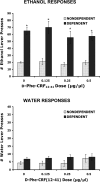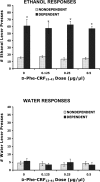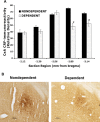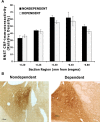Corticotropin-releasing factor within the central nucleus of the amygdala mediates enhanced ethanol self-administration in withdrawn, ethanol-dependent rats
- PMID: 17079660
- PMCID: PMC6674550
- DOI: 10.1523/JNEUROSCI.3096-06.2006
Corticotropin-releasing factor within the central nucleus of the amygdala mediates enhanced ethanol self-administration in withdrawn, ethanol-dependent rats
Abstract
Alcohol dependence is characterized by excessive consumption, loss of control over intake, and the presence of a withdrawal syndrome, including both motivational and physical symptoms. The motivational symptoms, including anxiety, have been hypothesized to be important factors eliciting excessive drinking during abstinence. Previous work has shown that ethanol-dependent rats also display enhanced anxiety-like behaviors and enhanced ethanol self-administration during withdrawal, likely resulting from dysregulation of brain corticotropin-releasing factor (CRF) stress systems. The present study was designed to explore the brain sites within the extended amygdala [central nucleus of the amygdala (CeA), lateral bed nucleus of the stria terminalis (BNST), and nucleus accumbens shell (NAcSh)] that mediate the increased ethanol self-administration observed during withdrawal. Ethanol-dependent animals showed an increase in ethanol self-administration after acute withdrawal relative to nondependent controls. The CRF antagonist D-Phe-CRF(12-41) ([D-Phe(12),Nle(21,38),C alpha MeLeu(37)]-rCRF(12-41)) was administered into the CeA, lateral BNST, or NAcSh of acute-withdrawn dependent and nondependent rats. Administered into the CeA, the antagonist reduced ethanol self-administration in dependent animals, with no effect in nondependent animals. Administration of D-Phe-CRF(12-41) into the lateral BNST and NAcSh was without effect on ethanol self-administration in dependent and nondependent animals. At the same time point of withdrawal, there was a decrease in CRF immunoreactivity within the CeA, suggesting an increased extracellular release of CRF during withdrawal. There was no change in CRF immunoreactivity in the BNST or NAcSh. These results indicate that CRF, specifically within the CeA, plays a role in mediating excessive ethanol consumption in ethanol-dependent animals.
Figures






References
-
- American Psychiatric Association. Ed 4. Washington, DC: American Psychiatric Press; 1994. Diagnostic and statistical manual of mental disorders.
-
- Baldwin HA, Rassnick S, Rivier J, Koob GF, Britton KT. CRF antagonist reverses the “anxiogenic” response to ethanol withdrawal in the rat. Psychopharmacology (Berl) 1991;103:227–232. - PubMed
-
- Becker HC. Alcohol withdrawal: neuroadaptation and sensitization. CNS Spectrums. 1999;4:38–65. - PubMed
-
- Becker HC, Lopez MF. Increased ethanol drinking after repeated chronic ethanol exposure and withdrawal experience in C57BL/6 mice. Alcohol Clin Exp Res. 2004;28:1829–1838. - PubMed
Publication types
MeSH terms
Substances
Grants and funding
LinkOut - more resources
Full Text Sources
Other Literature Sources
Medical
